Research on a Vehicle-Mounted Emergency Communication System Using BeiDou Regional Short Message Communication (RSMC) for Firefighting Operations in Forest Areas without a Public Network
Abstract
:1. Introduction
2. Materials and Methods
2.1. System Design
2.1.1. System Architecture
2.1.2. Design of Local Self-Organizing Network Terminals
2.1.3. Design of Satellite Communication Network Terminals
2.2. Experimental Setup
2.3. Experimental Procedure
- (1)
- When the fire breaks out (Figure 5a), Role B monitors the location of the fire through remote sensing satellite imagery at 45°22′ N, 127°30′ E;
- (2)
- Actor B sends the fire location and firefighting instructions to Actor A through the system, and A drives the forest fire truck to the fire scene according to the instructions (there is no ground network signal at this time (Figure 5b);
- (3)
- A reports the fire situation to B through the satellite communication link established by the system and fights the fire under the command of B (Figure 5c);
- (4)
- Forest fires were extinguished (Figure 5d).
2.4. Data Statistics
3. Results
3.1. Packet Loss Rate and LQI Analysis of Local Self-Organizing Network
3.2. Packet Loss Analysis for Satellite Communication Network
3.3. Signal-to-Noise Ratio Analysis of Satellite Communication Network
4. Discussion
5. Conclusions
- By combining BeiDou RDSS short message technology and Zigbee self-organized network technology, a vehicle-mounted emergency communication system using BeiDou RSMC for firefighting operations in forest areas without a public network was designed to realize emergency communication between on-site firefighting operators and a remote command center.
- Tests on the packet loss rate, LQI, and SNR of the emergency communication system were carried out. The results show that the system has excellent performance and can solve the emergency communication problem in forested areas without a public network, and the reliability of the system meets the requirements of actual firefighting operations.
- The designed emergency communication system can be mounted on different firetrucks, and other monitoring parameters can be added according to the actual application scenario; at the same time, it can also be matched with BeiDou communication cards with different frequencies and communication levels according to the specific use requirements.
Author Contributions
Funding
Data Availability Statement
Acknowledgments
Conflicts of Interest
References
- Sitnov, S.A.; Mokhov, I.I. A Comparative Analysis of the Characteristics of Active Fires in the Boreal Forests of Eurasia and North America Based on Satellite Data. Izv. Atmos. Ocean. Phys. 2018, 54, 966–978. [Google Scholar] [CrossRef]
- Armenteras, D.; Dávalos, L.M.; Barreto, J.S.; Miranda, A.; Hernández-Moreno, A.; Zamorano-Elgueta, C.; González-Delgado, T.M.; Meza-Elizalde, M.C.; Retana, J. Fire-induced loss of the world’s most biodiverse forests in Latin America. Sci. Adv. 2021, 7, 8. [Google Scholar] [CrossRef] [PubMed]
- Kumar, G.; Kumar, A.; Saikia, P.; Roy, P.S.; Khan, M.L. Ecological impacts of forest fire on composition and structure of tropical deciduous forests of central India. Phys. Chem. Earth 2022, 128, 13. [Google Scholar] [CrossRef]
- Chen, L.; Shao, P.; Chen, Z.; Chen, W. Construction and Application of Emergency Command and Communication System for Forest Fire Fighting. China Emerg. Rescue 2022, 3, 44–47. [Google Scholar] [CrossRef]
- Xu, C. Research on the Ability of Forest Fire Bridge to Cope with Large Fire Disasters. J. Wildland Fire Sci. 2023, 41, 63–65. [Google Scholar]
- Li, S. The Enlightenment to Forest Fire Prevention and Control in Southwest of China from the Study on “3·29” Forest Fire in Kunming Area in 2006. J. Saf. Sci. Technol. 2009, 5, 48–52. [Google Scholar]
- Xing, Z. Brief Analysis Our Country Wisdom Fire Fighting Construction—Take Xian Xi Xian District of Shaanxi Province as the Center Research. Master’s Thesis, Shanxi University, Taiyuan, China, 2023. [Google Scholar]
- Zong, X.; Tian, X. Research Progress in Forest Fire Behavior and Suppression Technology. World For. Res. 2019, 32, 31–36. [Google Scholar]
- Lippitt, C.D.; Stow, D.A.; Riggan, P.J. Application of the remote-sensing communication model to a time-sensitive wildfire remote-sensing system. Int. J. Remote Sens. 2016, 37, 3272–3292. [Google Scholar] [CrossRef]
- Hargreaves, D.; Knight, T.; Brownsword, P. MacDonald Dettwiler real-time emergency management via satellite—Status update and future directions. ISPRS-J. Photogramm. Remote Sens. 2003, 57, 273–280. [Google Scholar] [CrossRef]
- He, X. Forest fire monitoring system (I). Remote Sens. Technol. Appl. 1989, 1, 50–56. [Google Scholar]
- He, X. Forest fire monitoring system (II). Remote Sens. Technol. Appl. 1989, 1, 9–14. [Google Scholar]
- Dong, P.; Dong, K.; Ma, L.; Yu, X.; Wei, J. Estimation of forest fire overfire area based on Landsat8 remote sensing data--Taking the “3.18” fire in Hezhang County, Bijie City, Guizhou Province as an Example. Sichuan For. Surv. Des. 2022, 1, 14–18. [Google Scholar]
- Tan, X.; Li, X.; Liu, S.; Liu, Q.; Li, Z. Forest fire early warning and monitoring techniques using satellite remote sensing in China. Natl. Remote Sens. Bull. 2020, 24, 511–520. [Google Scholar]
- McClure, C.D.; Pavlovic, N.R.; Huang, S.H.; Chaveste, M.; Wang, N.X. Consistent, high-accuracy mapping of daily and sub-daily wildfire growth with satellite observations. Int. J. Wildland Fire 2023, 32, 694–708. [Google Scholar] [CrossRef]
- Park, B.-S.; Cho, I.-J.; Lim, J.-H.; Kim, I.-B. Forest Fire Monitoring System Using Satellite. J. Converg. Inf. Technol. 2021, 11, 143–150. [Google Scholar] [CrossRef]
- Kim, J.; Duk-jin, K. Satellite Imagery and AI-based Disaster Monitoring and Establishing a Feasible Integrated Near Real-Time Disaster Monitoring System. J. Korean Assoc. Geogr. Inf. Stud. 2020, 23, 236–251. [Google Scholar] [CrossRef]
- Sun, K.; Chen, Y.W.; Wang, P.; He, R.J. Application of agile Earth-observing satellite in disaster monitoring. Res. J. Chem. Environ. 2012, 16, 56–61. [Google Scholar]
- Dvorkin, V.V.; Karutin, S.N.; Kurshin, V.V. Method for monitoring the glonass global navigation satellite system by means of a differential correction and monitoring system. Meas. Tech. 2012, 55, 284–291. [Google Scholar] [CrossRef]
- Faeng, Y.; Lei, C.; Pan, Y.; Zhang, C. Forest fire monitoring based on satellite remote sensing technology. Geomat. Technol. Equip. 2022, 24, 15–19. [Google Scholar] [CrossRef]
- Li, Y.; Li, Q. Discussion on forest fire monitoring systems based on satellite data analysis. J. Wildland Fire Sci. 2019, 1, 25–29+43. [Google Scholar]
- Deng, S.; Ai, N.; Li, M.; An, Y.; Lei, J. Star-Earth Converged Communication Network Architecture for Forest Fire Emergency Communication Applications. Satell. Appl. 2022, 1, 55–60. [Google Scholar]
- Teng, B.; Yan, E.; Yan, Z.; Qiao, Y.; Zhang, R.; Cui, H. Research and Design of the Emergency Communication Scheme for Forest Fire. Softw. Guide 2020, 19, 192–196. [Google Scholar]
- Wu, H.; Tian, X.; Fu, L.; Wang, X. Application of Beidou Terminal in Forest Fire Early Warning Monitoring System. Satell. Appl. 2023, 1, 35–39. [Google Scholar]
- Tan, S. Innovative Development and Forecast of BeiDou System. Acta Geod. Cartogr. Sin. 2017, 46, 1284–1289. [Google Scholar]
- Liang, X. Research on Key Technologies of BeiDou-3 NavigationSatellite System RDSS Communication Service. Master’s Thesis, University of Electronic Science and Technology of China, Chengdu, China, 2023. [Google Scholar]
- Xie, J.; Zhuang, J.; Kang, C. Internet of Things Technology and Application Based on Beidou System. J. Nanjing Univ. Aeronaut. Astronaut. 2021, 53, 329–337. [Google Scholar] [CrossRef]
- IEEE 802.15.4-2020; IEEE Standard for Low-Rate Wireless Networks. IEEE Standards Association: Piscataway, NJ, USA, 2020.
- Padma, B.; Erukala, S.B. End-to-end communication protocol in IoT-enabled ZigBee network: Investigation and performance analysis. Internet Things 2023, 22, 100796. [Google Scholar] [CrossRef]
- Nafkha, A. Implementation and Comparison of Low Power Wireless Protocols in a Mesh Topology. Master’s Thesis, Instituto Politecnico de Braganca, Braganca, Portugal, 2021. [Google Scholar]
- Wang, J.; Li, C. The Development and Innovation of the BeiDou Navigation Satellite System. Stud. Hist. Nat. Sci. 2023, 42, 365–376. [Google Scholar]
- Yang, Y.; Xu, Y.; Li, J.; Yang, C. Progress and performance evaluation of Bei Dou global navigation satelite system: Data analysis based on BDS-3 demonstration svstem. Sci. Sin. 2018, 48, 584–594. [Google Scholar]
- Wei, Z.; Ma, M.; Yan, J.; Cai, W. Design of Wireless Fire Alarm System Based on CC2530. J. Astronaut. Metrol. Meas. 2021, 41, 66–71. [Google Scholar]
- Del-Valle-Soto, C.; Mex-Perera, C.; Nolazco-Flores, J.A.; Velázquez, R.; Rossa-Sierra, A. Wireless Sensor Network Energy Model and Its Use in the Optimization of Routing Protocols. Energies 2020, 13, 728. [Google Scholar] [CrossRef]
- Zhang, X.; Meng, Y.; Cai, Z.; Tian, B.; Cheng, X.; Qin, Y. Research on landslide monitoring data acquisition system based on Beidou short message communication and internet of things. Prog. Geophys. 2022, 37, 911–919. [Google Scholar]
- Tabouche, A.; Djamaa, B.; Senouci, M.R. Traffic-Aware Reliable Scheduling in TSCH Networks for Industry 4.0: A Systematic Mapping Review. IEEE Commun. Surv. Tutor. 2023, 25, 2834–2861. [Google Scholar] [CrossRef]
- Jaksic, B.; Todorovic, J.; Jovanovic, M.; Bandjur, M.; Bandjur, D. Impacts of Diversity Technique Application in Order to Reduce the Fading in IEEE 802.15.4 Networks. Appl. Sci. 2023, 13, 9775. [Google Scholar] [CrossRef]
- Cai, J.; Shu, Y.; He, W. Research on Channel Coding in Beidou Navigation System. Radio Eng. 2017, 47, 47–53. [Google Scholar]
- Gao, W.; Sui, Y.; Li, M.; Hu, Z.; Su, C.; Su, M. Application Mode and Usage Suggestion of BDS Downlink Navigation Signals for RNSS Service. Geomat. Inf. Sci. Wuhan Univ. 2023, 48, 1444–1454. [Google Scholar] [CrossRef]
- Yang, Y.; Li, J.; Wang, A.; Xu, J.; He, H.; Guo, H.; Shen, J.; Dai, X. Preliminary assessment of the basic navigation and positioning performance of the Beidou regional satellite navigation system. Sci. Sin. 2014, 44, 72–81. [Google Scholar]
- Sun, S.; Chen, J.; Ma, W.; Chu, J.; Yang, J.; Xu, J.; Tang, H.; Fu, L.; Sheng, J. A Kind of Tracked Forest Fire Fighting Vehicle. Patent CN108478964A, 4 September 2018. [Google Scholar]
- Sun, S.; Ren, C.; Li, T.; Chen, J.; Ma, W.; Chu, J. Trafficability analysis of improved forest fire engine based oncrawler chassis. Trans. Chin. Soc. Agric. Eng. 2018, 34, 61–67. [Google Scholar]
- Song, Z.; Pang, B.; Weng, Y.; Lu, H.; Xue, F. Application of BeiDou Short Message in Global Maritime Distress and Safety Communication Service. Navig. China 2022, 45, 65–69+77. [Google Scholar]
- Chu, X.; Wang, Y.; Jin, G.; Fan, H.; Zhou, Z. Variation in Growth and Wood Property and the Structure Differentiation of Schima superba Plantation with Different Sites, Stand Densities and Ages. Sci. Silvae Sin. 2014, 50, 152–159. [Google Scholar]
- Bruchwald, A.; Dmyterko, E. Stochastic model for calculating the volume of wind-broken and wind-thrown wood as well as of deadwood. Sylwan 2014, 158, 258–266. [Google Scholar]
- Lei, Y.; Mao, X. Integrating UAV-LiDAR and Sentinel-2 for Growing Stock Volume Estimation. For. Eng. 2023, 39, 46–54. [Google Scholar]
- Meka, S. Improving Link Quality Estimation in Zigbee Networks; Northern Illinois University: DeKalb, IL, USA, 2019. [Google Scholar]
- Nuruzzaman, M.T.; Ferng, H.W. Design and evaluation of an LQI-based beaconless routing protocol for a heterogeneous MSN. Wirel. Netw. 2020, 26, 699–721. [Google Scholar] [CrossRef]
- Shen, B.; Qin, J. A Novel SNR Estimation Method Based on Spread Spectrum Signal in Troposcatter Communication. Trans. Beijing Inst. Technol. 2021, 41, 873–877. [Google Scholar]
- He, Y.; Wang, Z.; Wang, Q.; Mao, Y. Quality Analysis of Observation Data of BeiDou Global Experimental Satellites. Bull. Surv. Mapp. 2018, 12, 1–5. [Google Scholar] [CrossRef]
- Ansari, K.; Bae, T.S.; Seok, H.W.; Kim, M.S. Multiconstellation global navigation satellite systems signal analysis over the Asia-Pacific region. Int. J. Satell. Commun. Netw. 2021, 39, 280–293. [Google Scholar] [CrossRef]
- Zhu, C. Research on Improved Design and Retrofitting Methods of Multifunctional Forest Firefighting Vehicles. China South. Agric. Mach. 2023, 54, 139–141. [Google Scholar]
- Li, M. 30 Python all-terrain forest firefighting vehicles passed the acceptance test. Dual Use Technol. Prod. 2020, 5, 65. [Google Scholar]
- Sun, S.; Zhang, S.; Li, Y.; Wu, J.; Chu, J. Studies of several large-scale forestry operating vehicles at home and abroad and prospect of vehicle type design. J. Beijing For. Univ. 2019, 41, 154–166. [Google Scholar] [CrossRef]
- Liu, Q.; Pan, X.; Wang, L.; Li, M. Reuse analysis of BeiDou-2 retired GEO satellite. In Proceedings of the 11th Annual China Satellite Navigation Conference—S02 Navigation and Location Services, Chengdu, China, 24 November 2020; p. 5. [Google Scholar]
- Lv, L.; Han, M.; Zhang, J.; Lv, Z. Comparative analysis of Beidou-3 and Beidou-2 satellite signals. Digit. Technol. Appl. 2022, 40, 14–16+124. [Google Scholar] [CrossRef]
- Feng, K.; Qiao, B.; Cao, L.; Hao, J.; Zhang, H. Analvsis of the Composition of Germplasm Resources of Forest Tree Seed Base in Heilongiiang Province. For. Eng. 2023, 39, 57–62. [Google Scholar]
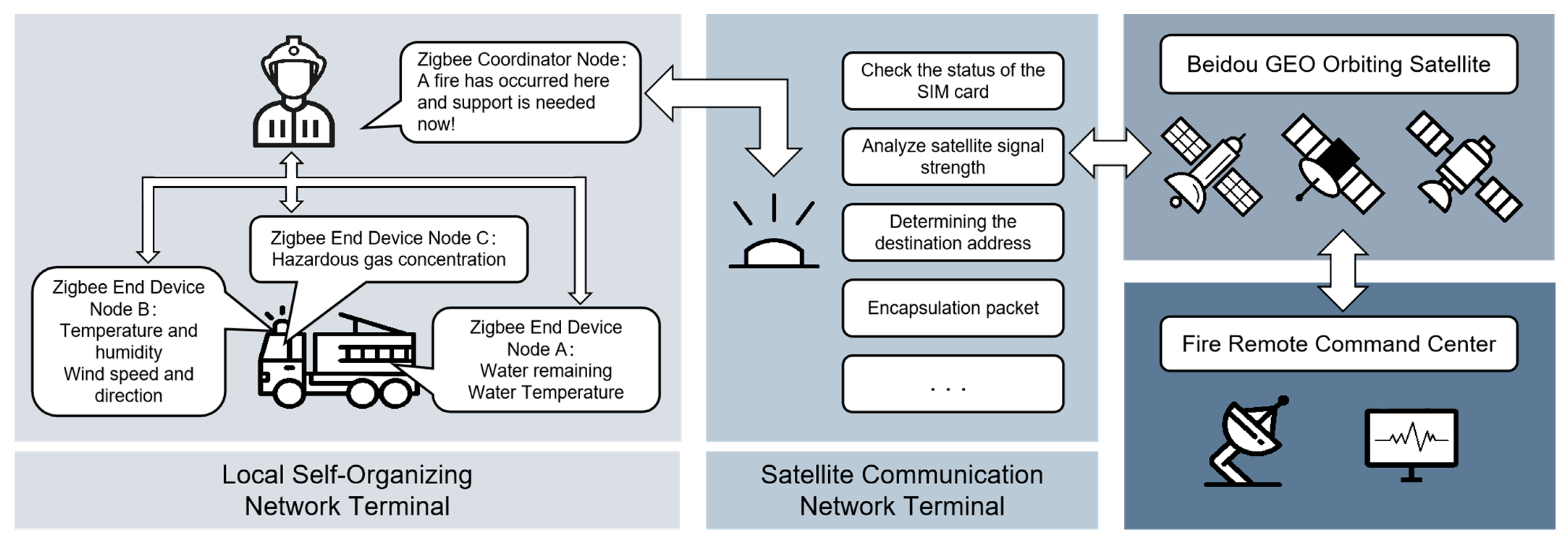

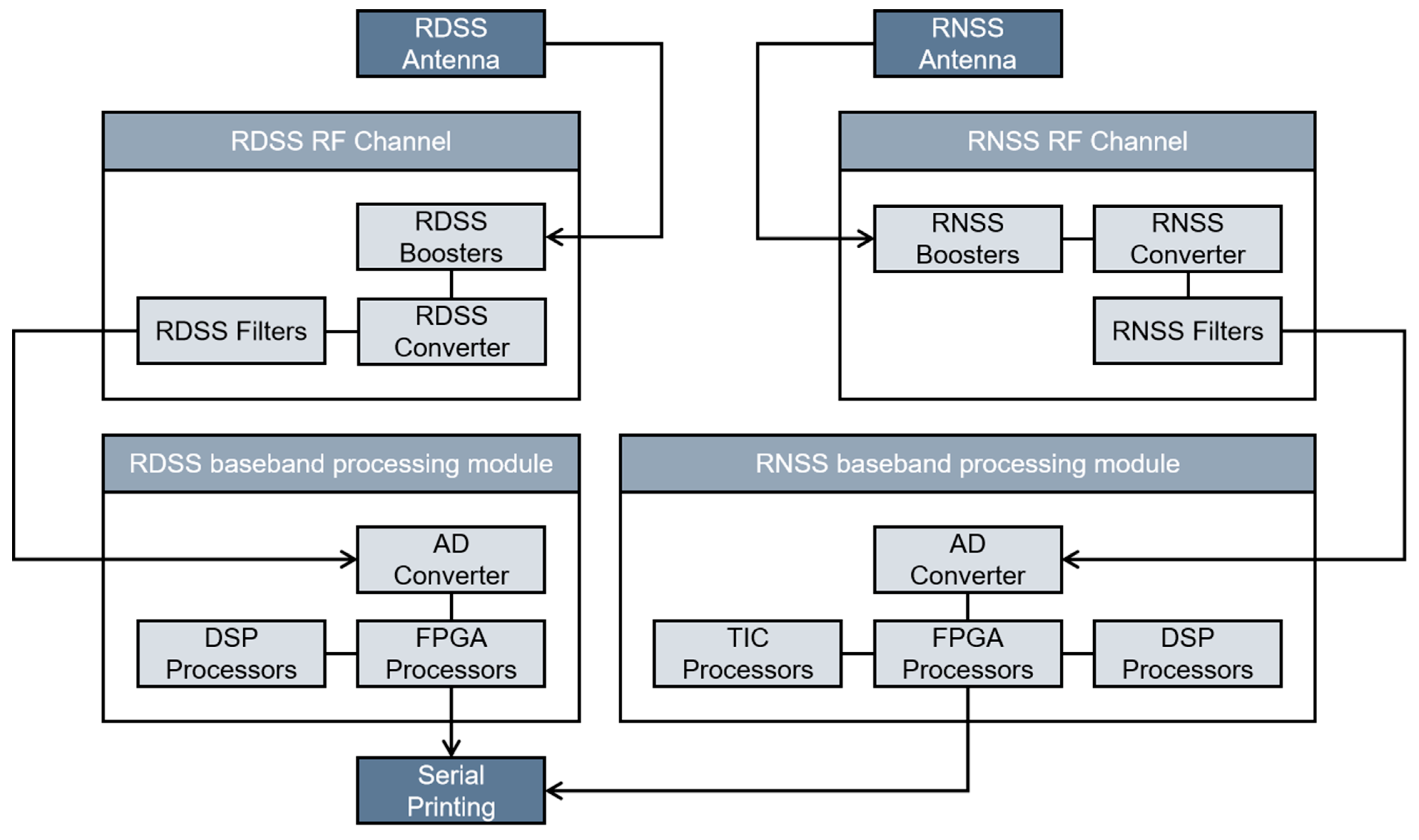

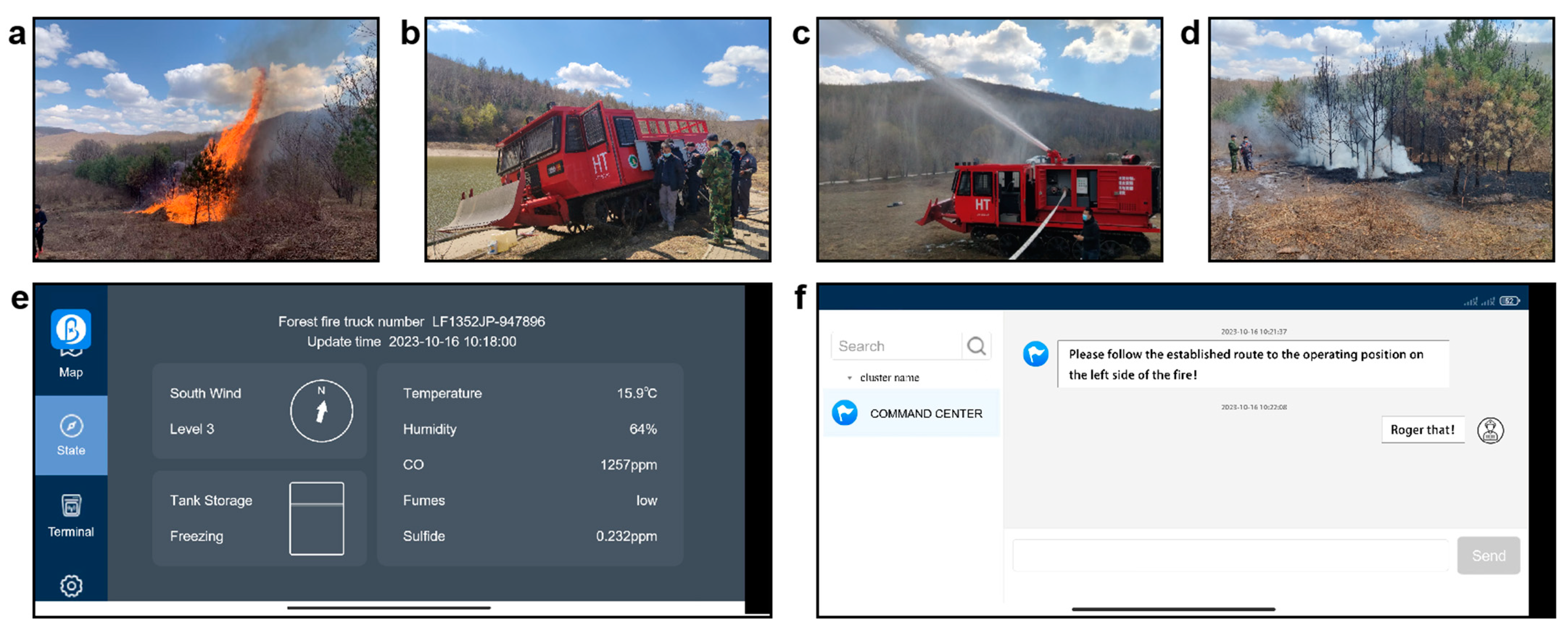
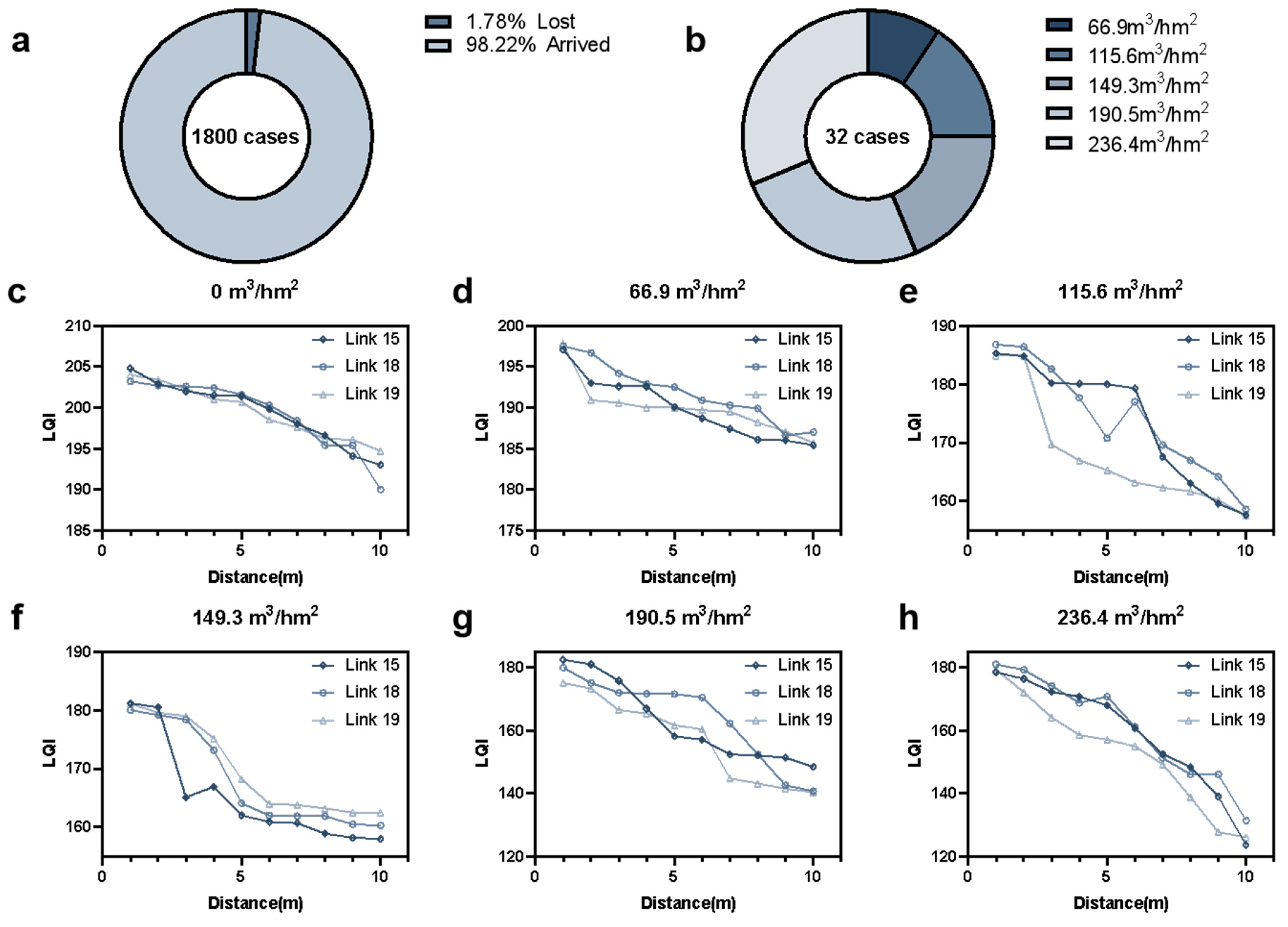

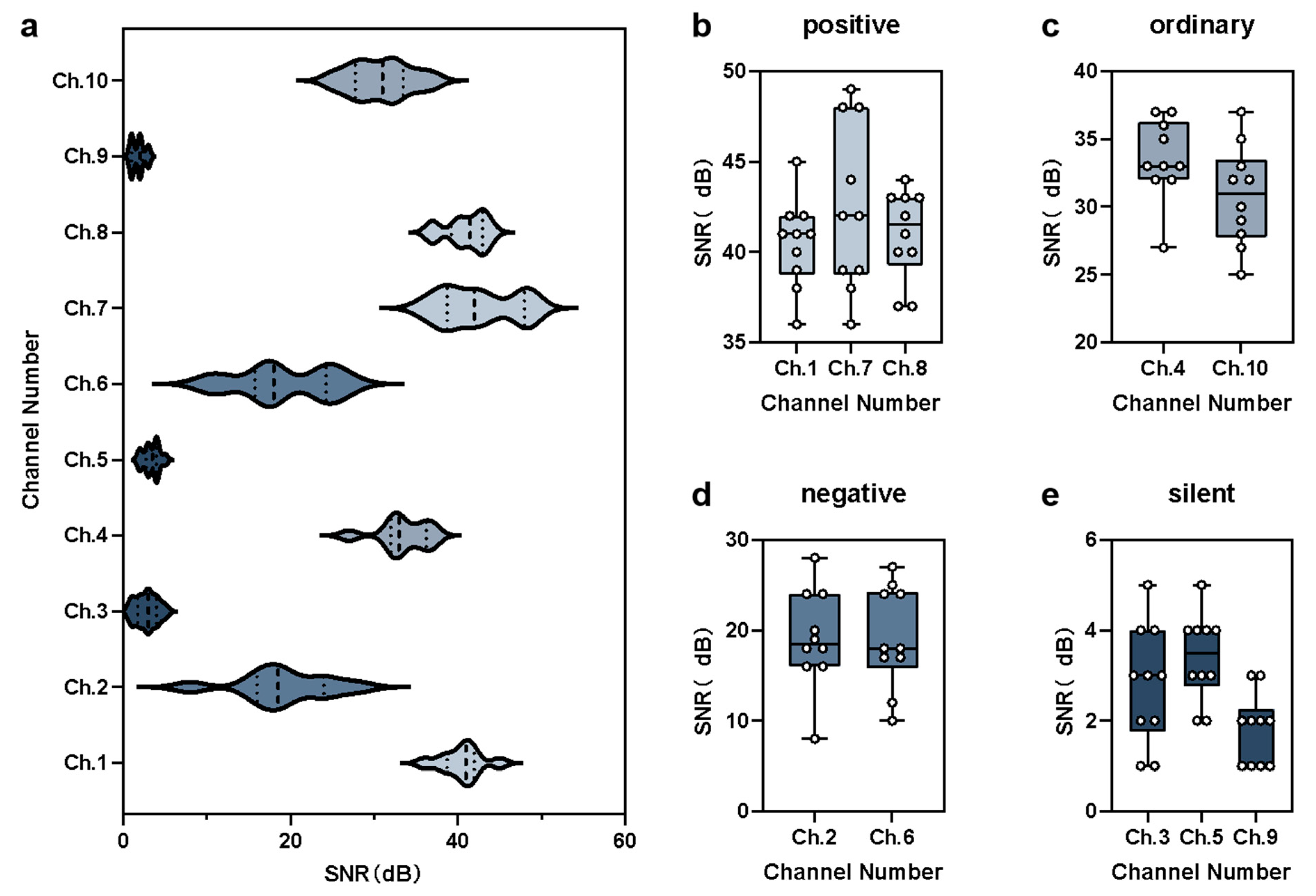
| Communications Technology | Bluetooth | Wi-Fi | Zigbee | Z-Wave | LoRa |
|---|---|---|---|---|---|
| General Connection Distance | ≤10 m | ≤100 m | ≤20 m | ≤30 m | ≤5 km |
| Power Wastage | Medium | High | Low | Low | Low |
| Self-Organized or Not | N | N | Y | Y | N |
| Common Application Scenarios | Proximity personal device connectivity | Multi-device high-speed transmission | IoT devices and environmental monitoring | Smart home and automation equipment | Remote sensor networks |
| Logical Role of Node | Connected Sensors | Parameters Monitored |
|---|---|---|
| Coordinator Node | -- | Summarize all parameters |
| End Device Node A | Input-level transmitter | Water remaining in tank |
| Infrared temperature sensors | Water temperature in tank | |
| End Device Node B | Temperature and humidity sensors | Temperature and humidity in environment |
| Wind speed and direction sensors | Instantaneous wind speed and direction | |
| End Device Node C | Carbon monoxide concentration sensor | Carbon monoxide concentration |
| Smoke concentration sensor | Smoke concentration | |
| Sulfide concentration sensor | Sulfide concentration |
Disclaimer/Publisher’s Note: The statements, opinions and data contained in all publications are solely those of the individual author(s) and contributor(s) and not of MDPI and/or the editor(s). MDPI and/or the editor(s) disclaim responsibility for any injury to people or property resulting from any ideas, methods, instructions or products referred to in the content. |
© 2024 by the authors. Licensee MDPI, Basel, Switzerland. This article is an open access article distributed under the terms and conditions of the Creative Commons Attribution (CC BY) license (https://creativecommons.org/licenses/by/4.0/).
Share and Cite
Xu, C.; Sun, S.; Zhou, Y.; Ding, Z. Research on a Vehicle-Mounted Emergency Communication System Using BeiDou Regional Short Message Communication (RSMC) for Firefighting Operations in Forest Areas without a Public Network. Forests 2024, 15, 1185. https://doi.org/10.3390/f15071185
Xu C, Sun S, Zhou Y, Ding Z. Research on a Vehicle-Mounted Emergency Communication System Using BeiDou Regional Short Message Communication (RSMC) for Firefighting Operations in Forest Areas without a Public Network. Forests. 2024; 15(7):1185. https://doi.org/10.3390/f15071185
Chicago/Turabian StyleXu, Can, Shufa Sun, Yuan Zhou, and Zian Ding. 2024. "Research on a Vehicle-Mounted Emergency Communication System Using BeiDou Regional Short Message Communication (RSMC) for Firefighting Operations in Forest Areas without a Public Network" Forests 15, no. 7: 1185. https://doi.org/10.3390/f15071185




